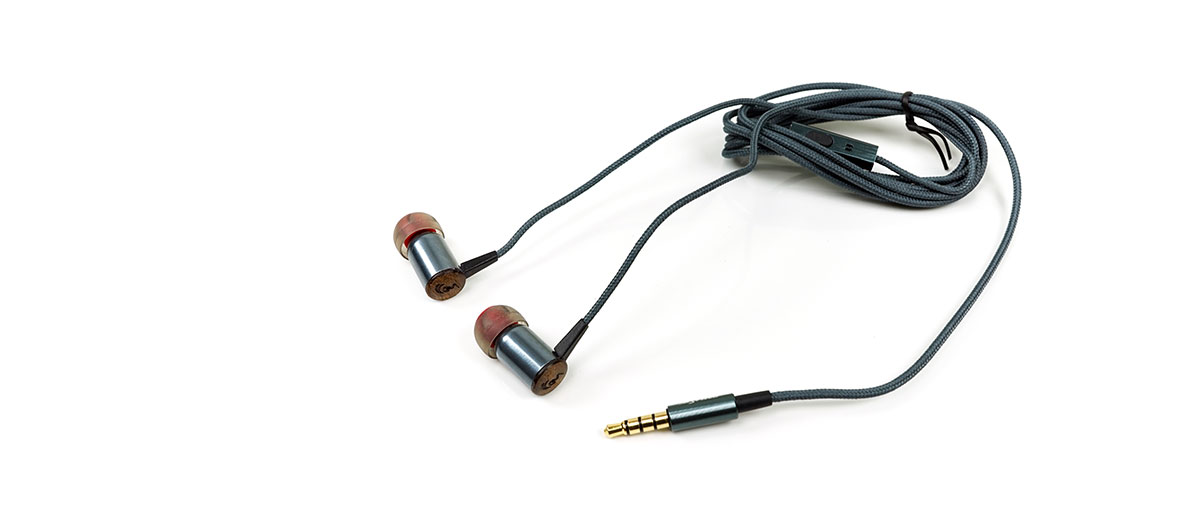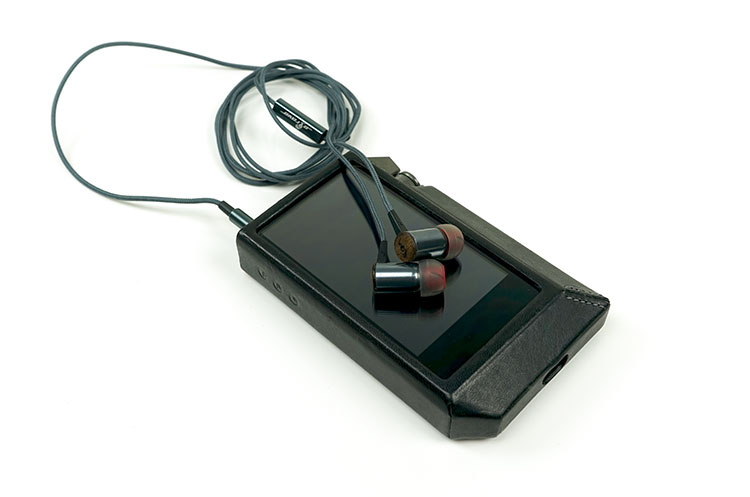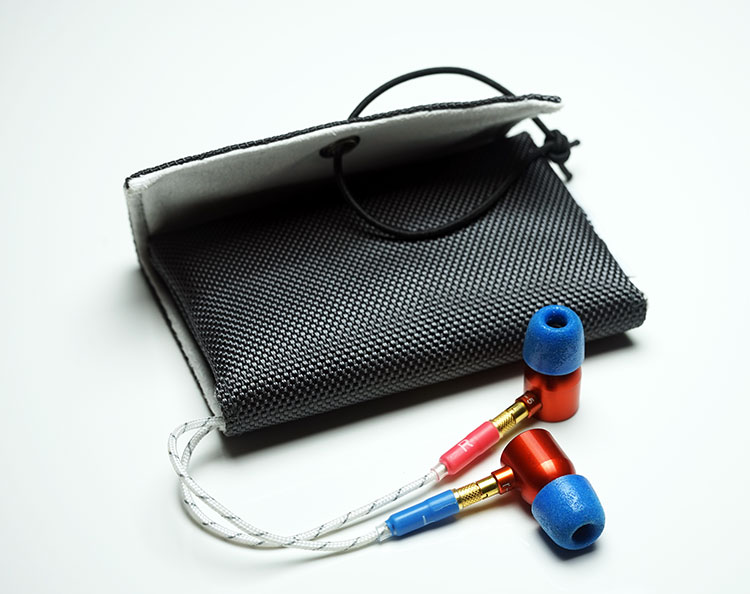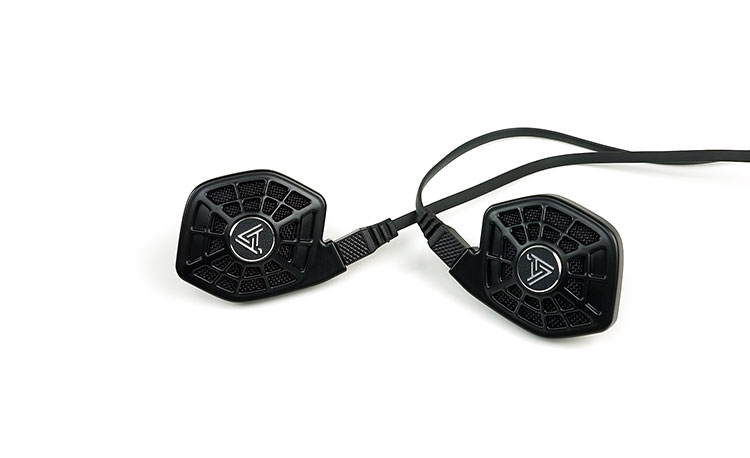Sound Impressions
Tuning
The ERIB-7 has a very unusual tuning. I say unusual because play it with the right genres it sounds rather fun, musical and forgiving in its performance. Play it with the wrong genres and it gets messy and very uneven sounding. The reason for that is the FR which in our measurements is more of an ‘M’ than a V-shape which most people might be used to.
More ‘M’ Than ‘V’
I say “more of” because there is a pronounced dip around 1-2k marker which has all the hallmarks of a recessed midrange most commonly found on a V-shape. However, it also has a muted sub-bass in terms of quantity that kills a little depth in its staging and robs it of absolute power that I would look for from a V-shaped IEM.
Instead, the low-end on the ERIB-7 rises and blooms from the mid-to-upper bass delivering plenty of warmth and forwardness into the lower-midrange. The resulting tuning is a thick sounding timbre for lower-pitched instruments such as bass guitar and a slightly forward staging position for them.
On the flipside, the upper mids on the ERIB-7 are fairly forward but not hugely open sounding courtesy of a relaxed treble response. Percussion does not have a huge amount of presence to shine though I do find the treble body to be quite good and free of any splashiness.
Improved Treble
One distinct area of improvement over the older ERIB-5a is the ERIB-7’s upper treble presence. It seems to have slightly better extension and a little more headroom over the ERIB-5a.
I still find it fairly relaxed overall just not as shelved down as the older sibling. I find a little bit of EQ around the 8k marker can help put a bit more bite into the percussion harmonics without creating any unnecessary sibilance.
Genre Synergy
This is a tuning most at home with EDM, synth wave and some forms of stripped down R’n’B. Anything really that doesn’t rely on an open midrange with precise control and instrumental separation.
This is where we go back to the original statement. With artists like Daniel Deluxe, Juno Dreams, Deadmau5, and certain tracks from the likes of Childish Gambino the ERIB-7 is fun sounding, forgiving and quite musical.
Strip the tracks down and vocal performances, both male and female, are smooth to slightly euphonic and fatigue-free. I had no issues listening to the likes of Dua Lipa and Iyeoka’s vocal deliveries on the ERIB-7’s more pronounced upper midrange.
However, slip-on come classic mid-centric rock, say Def Leppard or Metallica and it starts to sound more uneven. The lower the pitch of the vocal presence and the busier the mid-bass/lower-mids and that’s where you will find it wanting in terms of clarity.
Matchability
Efficiency
The ERIB-7 is rated at 16Ω and 105dB and is just marginally more efficient than the older ERIB-5a but not hugely so. You will need decent current and good volume headroom to get the best out of the ERIB-7. I got about a 2-3 step different in volume compared to the ERIB-5a on sources such as the FiiO X5iii, Sony 1, and the Lotoo Paw Gold Touch. All of them, however, were pushing quite high for volume levels.
For those looking to work with smartphones, I honestly have no issues with the ERIB-7 pairing. With the Huawei 20 (dongle) is sounded reasonably punchy and full-sounding with non-vocal EDM which is where I think the strength of this IEM lies.
With higher end DAPs such as the FiiO X5iii, you do get a better level of dynamic range and a tighter low-end. Compared to the P20 it also sounded a little more planted in the low-end and certainly more detailed.
One thing to note, the ERIB-7 is excellent with higher noise floors in both DAP and portable amps. You will hear nothing by way of hiss from iBasso amp cards, the FiiO X5iii
Synergy
A neutral source or amp will pair well with the ERIB-7. Given it already has a fairly warm low-end bloom you really do not want to overcook it. Sources such as the X5iii did ok for me but I preferred the DX120 from iBasso and the Onkyo Granbeat with their cleaner sound at that price range. Further up the HiBy Music R6 Pro was excellent also with the ERIB-7 with a fairly balanced and clean sound.
The ERIB-7 can scale a little also much like the older ERIB-5a. Not quite as spectacular as the full-range planar options such as the iSINE 10 or the ME.1 from UM but certainly a nice increase in dynamic range and better clarity from that midrange.
Portable amps such as the Bakoon HPA-01M whose current mode design is built for planars brought out a little more resolution and energy opening up those mids ever so slightly.
Even budget amps with good power like the A5 from FiiO will up the game slightly. If you are an EDM lover the A5 bass boost will come in handy otherwise for rock and vocal I suggest keep it switched off as it overpowers the mids of the ERIB-7 which is a weak spot.
Select Comparisons
oBravo ERIB-5a
£319.00
Technical
The specs of the ERIB-7 do seem almost the same at 35g weighting, aluminum enclosure and wood top plate. The driver config is almost the same with both using an 8mm planar driver. However, the dynamic driver size differs at 8mm for the ERIB-5a and 7mm for the ERIB-7.
The ERIB-5a also uses a detachable cable system with those proprietary MMCX connector systems. The cables in use will work with any other regular MMCX connector but try rolling a regular MMCX cable into the ERIB-5a socket and you cannot. These are very tiny connectors and not a lot of wire will fit into them. PW Audio’s 2-wire 1960s was one of the few we could source and its 5 times the price of the ERIB-5a which makes no sense.
Performance
Both of these monitors are rated at 16Ω, however, the ERIB-5a is rated as slightly less efficient at 102dB compared to the ERIB-7’s 105dB. Most likely this is due to the marginally smaller dynamic driver inside the ERIB-7 making it the slightly more responsive one to current.
The numbers play out in real life also with the ERIB-7 marginally more sensitive and requiring maybe a max 2-3 steps less volume on most sources we tried. This included the Lotoo Paw Gold Touch (82 vs 85 in unbalanced low gain), the HiBy Music R6 Pro (56vs58 in unbalanced low gain) and the FiiO X5iii, (78 vs 80in unbalanced low gain).
Tuning
I actually prefer the tuning on the ERIB-7 compared to the ERIB-5a due to a few differences they have, notably in the mid-bass to lower midrange and the upper treble.
The ERIB-5a presentation is cleaner sounding with a more neutral instrumental timbre compared to the ERIB-7. The ERIB-7 has a more pronounced mid-bass to upper bass hump and sounds the warmer of the two. The harmonic balance is, therefore, a little sweeter on the ERIB-7 with more even-harmonic emphasis. Neither have any sub-bass presence worth talking about so both lack a bit of depth in their staging.
Both also have substantially dipped midranges from around 1-2k which cast a little veil over some lower-pitched vocals and make them sound recessed and lacking in presence.
The final difference is an important one and that is the treble response. The ERIB-7 has more extension and air and does not sound anywhere near as rolled off as the ERIB-5a. This provides for a better level of headroom on the ERIB-7 and something a little more balanced sounding. More of a V-Shape in some regards than an M-shape when compared with the ERIB-5a.
Audeze iSINE 10
$399
Technical
The iSINE series are full-range open back planar monitors compared to the hybrid single DD and planar tweeter design of the oBravo ERIB range. Here the single planar is much bigger at 30mm compared to just 8mm on the ERIB-7 though it is required to cover the entire range compared to just the mids and highs.
Build
The design and purposing of both are very different, however. The completely open design of the iSINE 10 makes it almost on a mini open-back headphone level compared to the better sealing and smaller build of the ERIB-7.
Most will tell you the iSINE 10 has some fitting issues with those hooks so on a like for like basis the ERIB-7 is the comfier of the two and really much more of an IEM in handling and usage. The iSINE 10 is more of a stay at home or office usage scenario much like a headphone.
Cipher
The iSINE 10 uses a detachable cable system and an iOS-compatible Cipher cable that works wonders with DSP on iOS with that internal inline amp. The ERIB-7 is non-detachable with no DSP capability so if you are on an iOS you have only got apps EQ if you are lucky to have a jack. If not then you will need a BT dongle.
For DAPs, the Cipher cable does not apply and it is a more even playing field unless you upgrade the cable on the iSINE 10 which you cannot do with the ERIB-7.
Performance
The iSINE 10 is rated at 16 ohms and 120dB compared to the ERIB-7’s 16Ω and 105dB. These numbers play out pretty accurately with about a 10-step difference minimum in volume difference on the FiiO X5iii (70 vs 80 in unbalanced low-gain) and even higher on the PAW Gold Touch at 65 vs 85 in low gain unbalanced. Both are excellent for noise control, by the way. They are not the most efficient monitors out there.
Tuning
Very different types of tuning here. Courtesy of the open back design the iSINE 10 has a much more open presentation than the ERIB-7. The ERIB-7 has more of a traditional closed-in IEM sound with a more distinctive dynamic driver response. The iSINE 10 sounds every bit the planar driver monitor with a relatively linear low-end that extends very deep with relatively little roll-off compared to the ERIB-7.
The ERIB-7 has much less sub-bass and a warmer more elevated mid and upper bass. Instrumental timbre is warmer, thicker sounding on the ERIB-7 compared to what I think is a more accurate and natural sounding instrumental tone on the iSINE 10.
The midrange on the iSINE 10 is far more open with better detail retrieval and forward sounding vocal than the ERIB-7. However, the balance for vocals is a little off for me with a post 2k dip that robs them of a little more presence.
That dip on the ERIB-7 makes it sound a lot less intimate in part but also much more diffuse in its imaging with lower levels of resolution. Vocals are smoother, less shouty in part but sound overly veiled and swallowed up by that upper bass bloom.
Treble timbre is a weak spot on the iSINE 10 for me sounding a little peaky in the upper mids and lower treble. You get a little more sibilance and a harder edge to the percussion and some vocal timbre. The ERIB-7 is much warmer and less peaky in that regard so it is more forgiving but lacks a little air in comparison so also sounds a bit duller.
Unique Melody ME.1
$599
Technical
I was originally not going to include the ME.1 in our comparison as its SRP was $769. Now that it has dropped to $599 on Musicteck (bargain) it is worth having a small comparison though with the caveat that it is almost twice the price still.
Like the iSINE 10, the ME.1 is a large open back monitor design and will not give you too much in the way of passive noise isolation. Here the ERIb-7 will have an advantage in terms of seal. The ME.1, like the iSINE 10 is a full-range planar monitor though its planar driver is much smaller at 18mm compared to the 30mm inside the iSINE 10.
It is, however, much bigger than the 8mm planar tweeter inside the ERIB-7. A large part of the FR is covered by that 7mm neodymium DD inside the ERIB-7 so it does not need to be as big nor cover the same amount of frequency range.
The ME.1 does have more of an IEM fit though so its comfort levels are much superior to the iSINE 10
Performance
The ME.1 is rated at 23.1 ohms and 109dB compared to the ERIB-7 at 16Ω and 105dB. Both have similar levels of sensitivity with the ME.1 just being the marginally easier on the volume though not by much. Both have excellent levels of noise control so hissy higher noise floors will sound restrained and quiet on both such as the FiiO X5iii.
The ME.1 also scales a little better with good quality amping compared to the ERIB-7. I found older current mode amps such as the Bakoon HPA-01M delivered a better dynamic range than DAPs such as the FiiO X5iii when paired with the ME.1. The ERIB-7 also improves in terms of clarity and openness but the gap is not quite as big.
Tuning
Despite the open design of the ME.1, I do not find them as open sounding as the iSINE 10 but more open than the ERIB-7. What I found is a much better level of depth to the ME.1 low-end planar response with a very gentle mid-bass lift. The ERIB-7 will initially sound thicker on the low-end but it does not reach as deep delivering less power and more of a focus on warmth and bloom.
The ME.1 has a very natural instrumental tone to my ear, quite full-bodied in part but not quite as warmed up as the ERIB-7 due to its greater upper bass bloom and lower-midrange prominence around 500-800Hz. The UM planar tends to dip a bit more there and sounds the cleaner of the two for instrumental separation and tone.
The ME.1 has a fairly strong 1-2k emphasis so vocals are more forward to my ear and with better presence than the ERIB-7. The ERIB-7 sounds much more recessed and slightly veiled by comparison. Vocal timbre is warmer on the ERIB-7 and the thicker sounding of the two.
The ERIB-7 is a little darker of the two in terms of treble performance though not by much. It however fairly smooth sounding and forgiving in nature. It also has a bit more body than the ME.1 treble though slightly less air.
Our Verdict
The ERIB-7 is a step up from the older ERIB-5a tuning with a warmer more euphonic sound that is more than forgiving on the ear. However, it unusual tuning makes it a niche IEM more suited to some genres than others. EDM and synth-wave sound enjoyable with the ERIB-7 but rock less so. That is largely down to the uneven midrange tuning and upper bass and lower-midrange bloom which tend to favor the former over the latter.
I do wish it was a detached monitor also but in its favor, the smaller lightweight stems make it a more comfortable fit. Also, finding a compatible cable to roll an oBravo is more than difficult. The good news is the stock cable is the exact same one as you will find packed into the Ra C-Cu so it is not as if you are being short-changed with the non-detachable cable.
The pricing places the ERIB-7 into a really tough and saturated part of the market. Hybrids from China are pushing hard from all sides and quality crafted single BA designs from the likes of Campfire Audio and qdc are impressing. The ERIB-7 is certainly a better tuned entry-level than before and the build quality is very good but it has got its work cut out to capture some of that mentioned audience.
oBravo ERIB-7 Specifications
- TECHNOLOGY Planar Tweeter
- ENCLOSURE MATERIAL Aluminium
- COLOUR Steel
- DRIVER COUNT 2
- DRIVER CONFIGURATION 1 Planar Tweeter + 1 Neodymium Dynamic
- AUDIO RANGE 30Hz~35KHz
- PLANAR TWEETER SIZE 8mm
- DYNAMIC DRIVER SIZE 7mm
- SENSITIVITY 105dB
- IMPEDANCE 16Ω





